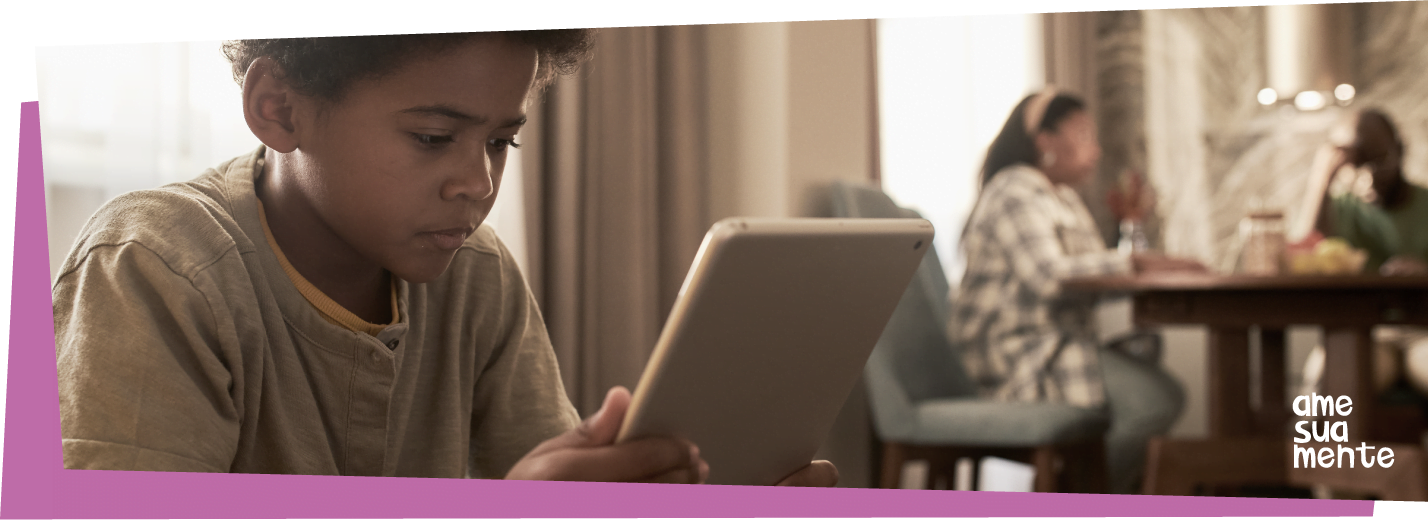
Did you know that, in Brazil, there are more cell phones than people?
In 2020, the country had 226.3 million cell phones and a population of 203 million Brazilians. In other words, 106.93 cell phones for each group of 100 inhabitants. Research shows that most of these devices are in the hands of children and teenagers:
- 82% of Brazilian children have access to the Internet (10 to 13 years old);
- 55% already have a cell phone (10 to 13 years old);
- 95% of children and adolescents between the ages of 9 and 17 across the country access the Internet, mainly social networks such as Instagram (66%) and TikTok (63%);
- In the United States, research shows that teenagers between 13 and 18 years old spend more than 6 hours a day on the Internet, not counting access due to school demands. Among children aged 8 to 12 years, the average daily use of screens is 4.6 hours.
Sources: Agência Nacional de Telecomunicações (ANATEL), 2022 Demographic Census / TIC Kids Online Brazil Survey / Rideout, 2015
Smartphones were popularized less than 20 years ago and have already become almost ubiquitous objects in everyone’s lives. However, technology has evolved faster than our ability to adapt. The fact is that several studies suggest the impact on mental health caused by excessive screen time, especially in childhood and youth.
In recent years, we have observed a worrisome increase in cases of mental disorders and suicide among children and adolescents. Some studies also demonstrate a reduction in the cognitive capacity of this population.
An issue of extreme importance that demands action from all actors in society.
In 2022, for the first time in history, anxiety records among children and young people exceed those among adults, as shown by Folha’s analysis based on data from the SUS Psychosocial Care Network (RAPS), available from 2013 to 2023.
In 2023, the rate of patients aged 10 to 14 treated for anxiety disorders was 125.8 per 100,000 and 157 per 100,000 among young people aged 15 to 19, rates that exceed the rate of 112.5 per 100 thousand for people over 20 years old.
The 2023 World Happiness Report, prepared by the UN, also points to a trend towards a greater feeling of unhappiness among young people. The information contradicts the trajectory, previously considered normal, which points to more happiness in youth, with a drop in adult life and a resumption in old age, the so-called “U” shaped trajectory.
Of course, the pandemic has had a major impact on the mental health of this group, with adolescents accounting for 14% of mental disorder cases in 2019, rising to 36% in the post-pandemic period.
However, there is evidence that contemporary lifestyle habits – in which the Internet and social networks play a central role – have contributed to worsening mental health, especially among digitally native children and adolescents.
Given this scenario, the debate on the use of cell phones by younger people is pertinent and urgent.
Source: data from PISA Global – international student assessment carried out by the OECD – Organization for Economic Cooperation and Development).
Author and social psychologist Jonathan Haidt in his new and acclaimed book “The Anxious Generation” – points to social networks as largely responsible for the increase in cases of depression among teenagers.
“We are overprotecting our children in real life and not protecting them enough online.” –Jonathan Haidt
Although technology brings countless benefits, facilities and connections, we need to learn to deal with it better.

“With WhatsApp and other networks, work invades our family life and leisure. We need to learn to set limits, without losing productivity. If we are unable to rest, we end up having our productive capacity reduced and the risks of developing mental health problems increased” – says psychiatrist and president of Instituto Ame sua Mente, Rodrigo Bressan.
If for us adults, the mission of managing the role of technology in our daily lives is already quite challenging, imagine how challenging it is for children and young people who do not yet have the emotional repertoire and ability to set such limits. As this is a habit that is harmful to mental health and school performance, attention and interference from parents and caregivers is necessary.
Restricting the use of cell phones in schools
Restricting the use of cell phones in schools is a topic that has been intensely debated in Brazil and around the world. In the United States, a mothers’ organization took legal action against Meta asking them to take measures to minimize the addictive effect of the platform’s social networks.
In São Paulo, the bill that prohibits the use of devices with Internet access by students in schools is being discussed in the Legislative Assembly. Interventions from other countries can be used as a reference, such as Spain, where banning the use of cell phones in the school environment has been shown to reduce bullying in 10% to 18% of cases.
Following the trend, mothers’ organizations in Brazil begin to appear, such as the “Movimento Desconecta,” which aims to influence the decision to completely restrict the use of cell phones in schools. The initiative also advocates that there be an agreement between parents and children so that young people only have access to smartphones at the age of 14 and that they only access social networks from the age of 16, reducing the social barrier to postponing these habits.
“Any tremor on a cell phone makes a person lose focus,” highlights Rodrigo Bressan. The point is corroborated by a study by Common Sense Media that estimates that young people receive, on average, 237 notifications per day on their cell phones.
“Furthermore, social media content is not always beneficial for young people and reduces sociability. One of the ways in which schools educate is by promoting sociability and mediating conflicts,” concludes the psychiatrist.
Taking care of the mind is taking care of ourselves! The sooner the better!










